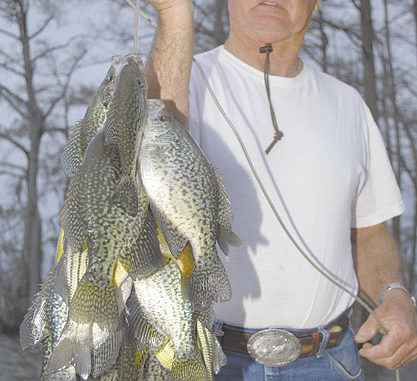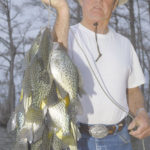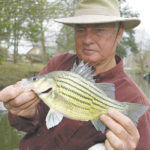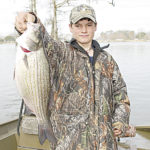
Crappie and catfish will be on your menu if you spend a day — or a week — at this underfished oxbow lake.
“I’m a catch-and-release fisherman,” says 63-year old Charles Johnson. He is sitting at a campfire in the Johnson Compound at the Lake Bruin State Park Campground. “I catch them and release them into the ice chest.” Vernon, his 67-year old brother, grins and adds, “Yeah, we like to eat ‘em.”
Each year between February and June, the two old bulls can often be found at the center of a gang of up to six motor homes and travel trailers clustered in one corner of the campground, right on the banks of Lake Bruin. The brothers typically arrange at least three, and often more, two-week trips to the campground during the five-month period.
Their trips rank in the order of African safaris. Under the awning of Charles’ 23-foot travel trailer sits something seldom seen in campgrounds — a 7-cubic foot electric freezer, like the kind most folks have at home. It comes full of steaks, venison, wild hog meat and containers of ice. As the meat in it disappears, it is replaced by surplus fish fillets from their catches. And of course, he continues to make all the ice the brothers need for their ice chests.
Next to the freezer are not one but two heavy duty deep fryers and a commodious electric grill.
The awning of brother Vernon’s 33-foot motor home shelters an outdoor TV, another electric grill and an electric griddle. He serves his wine in glass stemware, and his outdoor table always has a purple and gold tablecloth on it.
Joining the brothers will be their mother, cousins, nephews and nieces, grandkids and family friends. They all eat fish, and freshly fried fish are eaten at least every third day. Fortunately, Lake Bruin offers a surfeit of great table fish — black crappie, channel catfish, flathead catfish, largemouth bass, spotted bass, bluegill, yellow bass and hybrid striped bass. Crappie, invariably called white perch in the area, and large channel catfish are especially abundant.
Both men love to fish, but they have different philosophies.
“I like catching fish a whole lot more than fishing for them,” elder brother Vernon says. “If they aren’t biting, I don’t fish. Now, Charles, he’s different. He’s a yellow-dog fisherman; if he gets one bite, he’ll be there for four hours.”
Charles grins, shakes his head and pulls more golden-fried crappie fillets out of the dual deep fryers he is operating.
“I guess I have to admit that I live to fish and hunt,” he says. “I love either one. A lot of the time I do both of them at once.”
Off to one side, sitting in her lawn chair, Charles’ wife Linda rolls her eyes.
The brothers like to cook, so something is always cooking at the Johnson Gang headquarters. Today, while Charles is frying fish, Vernon is prepping the ingredients for the evening meal, chicken and sausage jambalaya. His wife Faye is watching in approval from her lawn chair.
While cooking and fellowship is an important part of the Lake Bruin ritual for the two men, there is no doubt as to why they are really here. They are here to fish, especially Charles. Vernon fishes every day, and Charles does the best he can to fish all day every day. Their tools of choice are yo-yos, limb lines and ultra-light rods and reels rigged with mini tube jigs.
“People who think fishing yo-yos is unsporting are wrong,” Charles says. “It takes as much knowledge to fish them properly as it does for any other tackle. And just like when using rods and reels, sometimes the fish bite and sometimes they don’t. It is really exciting when the fish are really biting, and you can’t keep them baited fast enough.”
The first few days of the trip, the two men keep their three dozen yo-yos baited with shiners most of the time, except during the middle of the day. Shiners are equally attractive to crappie and channel catfish.
Later in the trip, when the crappie bite slows down and shiners prove difficult to catch, they use crawfish, which prove to be excellent bait for 3- to 8-pound channel catfish. Catalpa worms, when they have them, are also excellent catfish bait.
The yo-yos are all hung from the lower limbs of the statuesque cypress trees in the lake between the State Park Campground and the canals of the Gladstone Subdivision on the southeastern end of the lake. The Johnsons’ strategy is to hang the yo-yos to fish in waters 2 to 8 feet deep, and then when they find out where the fish are biting, move the rest of the yo-yos to trees in the water depth where the bite is best.
When the bite is on, Charles likes to bait the yo-yos in the evening before dark, run and rebait them at 8 or 9 p.m., run and rebait them again at 4 a.m. and then run them again after daylight is well on the water and he has taken his crack at crappie with tube jigs.
When he isn’t able to catch shiners in his cast net, he has to buy them. Shiners purchased from bait shops are expensive, so he seldom baits the yo-yos with them during daylight hours, when bream and turtles are prone to peck them off the hooks.
As big a kick as the two get out of running yo-yos, the real backbone of their fishing effort is done with ultra-light spinning equipment, rigged with pear-shaped corks, 1/32-ounce jig heads and tube jigs. They keep it simple. The vast majority of time they use blue/white tubes; the rest of the time it is chartreuse/black.
Their technique is simple but deadly. The cork is set 18 to 24 inches above the jig. No snap or swivel is used. The retrieve is made by twitching the rod tip while gently sweeping the rod backward, causing the cork to bobble about 8 or 10 inches forward. Then the cork is allowed to rest still while the slack in the line is retrieved. Most of the hits come during the pauses.
Crappie and yellow bass can’t resist the offering. Black bass, many of them of respectable size, also jump on the baits enthusiastically. A fish that will excite the brothers as much as a big slab crappie is a 4-inch or so bluegill or other bream. These are carefully unhooked and released into a bait bucket.
They are destined for use as live bait on limb lines. Relatively simple, limb lines, the way they rig them, are 6-foot pieces of tarred nylon twine with large snap swivels holding 4/0 or larger hooks tied to one end. The lines are tied to green and limber cypress limbs overhanging 3 to 8 feet of water.
Vernon especially loves limb lines baited with bream because they produce his favorite table fish, flathead catfish, which he calls “yellow cats.” At very least, limb lines are good for one of Lake Bruin’s over-sized channel catfish. The two men set limb lines along the sides of Lake Bruin and north of the campground, as well as south.
Early in the season, February and March, they do almost all of their jig fishing in the canals of Gladstone Subdivision, located in the end of the lake south of the state park, or in what is known as the Lagoon, a short, bayou-like arm of the lake that extends into the state park.
Their belief is that the shallow waters of these two areas warm up faster than the main body of the lake, providing the best fishing early in the year. Also, the subdivision’s canals, as well as the Lagoon, are well-protected from February and March’s notorious winds.
“Sac-a-lait seem to like to spawn in small little places off of the main body of water,” Charles says. “Sometimes these canals are lousy with them, and yellow and largemouth bass too.”
On the early trips the brothers make, usually in February and March, but sometimes even in January, they target crappie, although they catch other fish as well. During this period, live bait is tough to find. Shiners and shad aren’t schooling at the campground’s lights and bream are still inactive in the cold water of those months.
During April, crappie fishing is still good, but beginning to slack off. May offers less crappie and more catfish and bream. When water temperatures climb over 75 degrees, crappie fishing disappears in shallow water and the anglers tend to fish a lot more yo-yos and limb lines in the main body of the lake.
By June, schools of small garfish become so active that even yo-yos become difficult to fish. But this month, the last month that they fish the lake, is prime time for limb lines baited with bream and crawfish.
After June, they typically quit the lake until the next year. In between, Charles concentrates on redfish and trout fishing at his camp at Pointe aux Chenes and then later hunting. Vernon rests up until September, and then follows his other great love, tailgating with his motor home at LSU football games.
Come February, they will be back though.
“This is our favorite campground in the United States,” Vernon says. “And the fishing is great; you can’t beat the
variety.”





